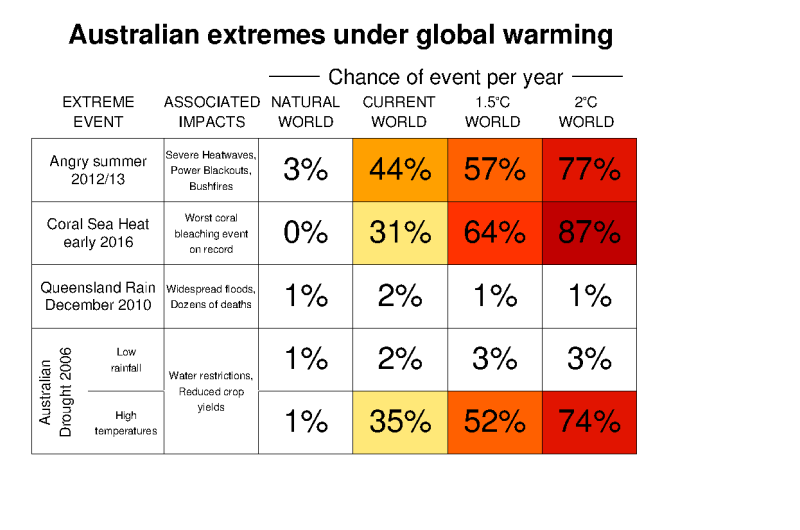Heat on for Australia's Great Barrier Reef when global temperatures hit 1.5C

If global temperatures hit 1.5°C above pre-industrial conditions—the target negotiated at the 2015 Paris Agreement—it will be twice as likely that we will see a repeat of the extreme ocean heat that severely damaged the Great Barrier Reef in 2016.
If the world pushes temperatures up to 2°C more than the pre-industrial world, then it almost triples the odds of the heat associated with a mass bleaching event.
These findings from University of Melbourne Scientists at the ARC Centre of Excellence for Climate System Science, reported today in Nature Climate Change, are the result of research looking at how Australian extremes in heat, drought, precipitation and ocean warming will change in a world 1.5°C and 2°C warmer than pre-industrial conditions.
"Most of the action occurred in changes to extreme heat, with big increases in events similar to the Angry Summer of 2012/13. Events like this occurred in most years once global temperatures reached 1.5°C and 2°C warmer than pre-industrial times," said lead author Dr Andrew King.
"But the heat of 2016 in the Coral Sea was unprecedented in our modelling of the pre-industrial period. There was no event where the Coral Sea was as warm as we saw in 2016 but as the globe warms these events will grow in number."
The researchers also looked at other extreme events, like the southeast Australian drought of 2006 and the rain events that led to widespread flooding in Queensland in 2010, to see whether they would occur more often as global temperatures increased.
Rainfall did not show any clear change because the impacts of natural variability, like the El Niño Southern Oscillation, monsoons, Indian Ocean temperatures and the Madden-Julian Oscillation, had more influence on precipitation than rises in global temperatures.
There were some increases in drought intensity as a result of increased heat but the weak reduction in rainfall meant only a slight increase in the frequency of droughts was detected.
The results came after modelling thousands of years under four different scenarios—pre-industrial conditions, current conditions, the world at 1.5°C and at 2°C—on supercomputers at National Computational Infrastructure.
The researchers then looked at four key extreme Australian events—the Angry Summer 2012/13; the Coral Sea marine heatwave of 2016; the severe rain event in Queensland in 2010; and the 2006 drought in southeast Australia—to model how often similar events could occur under each scenario.
"It quickly became clear that keeping global temperatures under 1.5°C had a clear benefit for Australia in terms of reducing extreme events and the costs that come with them," Dr King said.
"It also gave us a grim warning about what would happen to the Great Barrier Reef if we fail to act on the Paris agreement. Sea temperatures of the scale and frequency we have seen do not bode well for the future of one of our greatest natural wonders."
More information: Australian climate extremes at 1.5 ◦C and 2 ◦C of global warming, Nature Climate Change (2017). DOI: 10.1038/nclimate3296
Journal information: Nature Climate Change
Provided by University of New South Wales





















